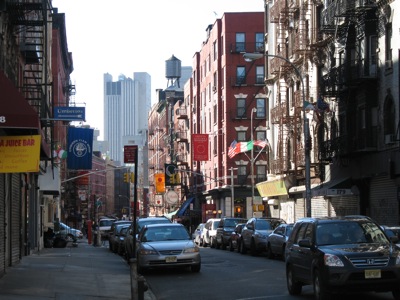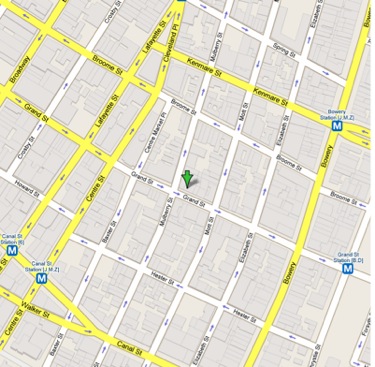Little Italy
From Decoding New York
| Introduction |
| Little Italy |
| * Evolution |
| * Here v. There |
| * Economy |
| * What's Real |
| Koreatown |
| * Evolution |
| * Here v. There |
| * Economy |
| * What's Real |
| Comparison |
| * Photo Gallery |
| * Sources
|
Little Italy is today bounded by Houston Street to the north, Mulberry Street to the east, Canal Street to the south and Lafayette Street to the west. Its historical boundaries were the same north and south, but to the Bowery on the east, and Broadway on the west. Another area where Italian immigrants settled was south of Washington Square along Thompson and Sullivan Streets, where some Italian businesses and residents remain, but this site is focused on the Mulberry Street area.
Italian colors, flags, restaurants, stores, and a few parishes preserve the spirit of Italy. As you walk through the neighborhood, surrounded by traditional tenement buildings with fire escapes, cobble-stoned streets beneath your feet, and Italian music and scents wafting from numerous restaurants or stores, you’ve got the basic atmosphere of Little Italy. What is unique to the neighborhood of Little Italy is its method of preservation. “Little Italy has become Littler Italy,” as fewer and fewer Italian-Americans reside there and more Asians take their place. According to the 2000 census, about 8,200 Asians resided there versus 1,000 Italian-Americans. Asians outnumber the Italians by eight times in Little Italy! Despite the overwhelming difference, the Little Italy community and the city government have chosen to “freeze” its Italian ethnic identity. A plan to open an Italian American Museum within Little Italy is in progress. The Museum will become a “symbolic place”, that will “demonstrate the continuance, the old and the new” by memorializing the history and culture of Italian-Americans. Little Italy is constantly changing and even though Little Italy has decreased in size, “Little Italy is growing.” As a resident says, “Sure, it can feel like an Italian-American theme park. Sure, Chinatown enveloped it long ago. Sure, there are just so many ‘Fuhgeddaboudit’ T-shirts and ‘Parking for Italians Only’ joke signs that anyone can take. Sure, the number of honest-to-goodness Italians living in the neighborhood has been small for many years” but in the end, Little Italy is here to stay. People visit Little Italy for what it is now, a blend of Italian culture and American culture.
For a map of Little Italy: http://www.littleitalynyc.com/restaurants.asp


